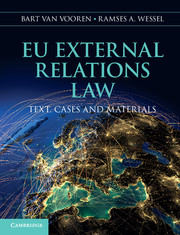Book contents
- Frontmatter
- Contents
- Table of cases
- Table of instruments and legislation
- Preface
- Acknowledgements
- List of abbreviations
- 1 The EU as a global legal actor
- 2 Instruments of EU external action
- 3 Existence of EU external competence
- 4 Nature of EU external competence
- 5 Scope and choice of EU external competence
- 6 The duty of cooperation
- 7 EU law and international law
- 8 The EU and international institutions
- 9 Common Commercial Policy
- 10 EU development policy
- 11 Common Foreign and Security Policy
- 12 Common Security and Defence Policy
- 13 The external dimension of the internal energy market
- 14 The external dimension of freedom, security and justice
- 15 The EU and its neighbours
- Index
- References
8 - The EU and international institutions
- Frontmatter
- Contents
- Table of cases
- Table of instruments and legislation
- Preface
- Acknowledgements
- List of abbreviations
- 1 The EU as a global legal actor
- 2 Instruments of EU external action
- 3 Existence of EU external competence
- 4 Nature of EU external competence
- 5 Scope and choice of EU external competence
- 6 The duty of cooperation
- 7 EU law and international law
- 8 The EU and international institutions
- 9 Common Commercial Policy
- 10 EU development policy
- 11 Common Foreign and Security Policy
- 12 Common Security and Defence Policy
- 13 The external dimension of the internal energy market
- 14 The external dimension of freedom, security and justice
- 15 The EU and its neighbours
- Index
- References
Summary
Central issues
This chapter explores to what extent the EU Treaties, secondary legislation and case law regulate the position of the EU in international institutions, understood as both formal international organizations and the less formal treaty-regimes. As highlighted by the position of the EU in the WTO in particular, the division of competences between the EU and its Member States forms an important part of this legal framework.
The Treaties list a number of general and specific competences related to the participation of the EU in international institutions. This chapter will list and analyse those provisions in order to assess the legal possibilities in this area.
The EU participates in many international organizations and other international forums. In which international institutions does the EU have a formal position, and which different forms of representation can be discovered?
Two examples deserve special attention: the WTO and the UN. On the basis of the participation of the EU in these two major organizations, we will further analyse the complexities related to this international role of the EU.
Finally, the active participation of the EU in international institutions leads to a number of normative effects of these organizations on the EU. What is the influence of international institutions on the EU?
Introduction
As explained in Chapter 1, with the entry into force of the Lisbon Treaty, the EU has entered a new phase. No longer is the world confronted with both the EC and the EU as actors on the international stage; since 1 December 2009 the EU acts as the legal successor to the EC (Article 1 TEU), while maintaining one of its original policy fields: the foreign, security and defence policy (see Chapters 11 and 12). The EU has thus also replaced the Community in international institutions. In addition, the Lisbon Treaty increased the number of references to the role of the Union in the world and to its relationship with the United Nations (Article 21 TEU).
- Type
- Chapter
- Information
- EU External Relations LawText, Cases and Materials, pp. 246 - 275Publisher: Cambridge University PressPrint publication year: 2014



